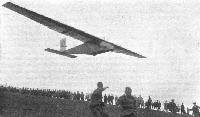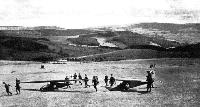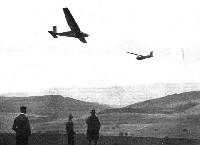
M.Simons The World's Vintage Sailplanes 1908-45
THE VAMPYR
The Vampyr was a product of the Akaflieg of Hannover Technical University. Working to a basic design by Dr Georg Madelung, the students Martens, Hentzen and Blume tackled the detailed work for part of their diplomas. Madelung chose a high wing layout to free the upper surface from flow disturbances, and devised an ingenious tricycle landing gear of three spherical footballs, pivoted on axles. Two large wingtip protecting pads were provided. The fuselage nose section was covered by plywood to make a box enclosing the cockpit. Aft of the wing the ply skins extended to the tail on the sides of the fuselage but the upper and lower surfaces were fabric. The rear end was wedge-shaped, carrying the tailplane clear of the ground for take-off and landings, the pilot being seated upright under the leading edge of the wing.
The wing structure was unique in its day and set a fashion that was to persist for more than forty years in advanced sailplane design. It was also frequently adopted for powered aircraft. Madelung called for a near-cantilever monoplane with a high aspect ratio. A single short strut was used near the wing root to relieve the highest stresses. There was only one spar, a deep, 'I'-sectioned beam, flanges of fir with a web of plywood fretted out to reduce weight. This took all the bending loads and was placed at the deepest point of the Goettingen 441 aerofoil section. Normally, whilst such a member could carry simple vertical loads, it would twist and break as the centre of pressure on the wing moved back and forth at changing airspeeds. Previous designers had added complex wire bracings or heavy internal cross members to stiffen such wings, or had abandoned the monoplane layout in favor of biplanes or even triplanes. The Vampyr obtained its torsional stiffness from its skin; one of the first known applications of stressed skin in aircraft design. A thin plywood sheet was glued to the top of the mainspar, bent and carried round to the lower flange of the spar over the light nose ribs and token leading edge member. This created a tube of 'D’-shaped cross section, of great strength and stiffness. Probably almost as important, the plywood skin over the entire front third of the wing chord ensured that the wing profile was accurate, a very great advantage. Behind the spar it reverted to fabric over ribs in the interest of lightness. The arrangement was immediately copied by almost every other sailplane designer and became standard practice.
The Wasserkuppe meeting in 1921 was something of a disappointment until Klemperer on 30th August managed at last to exceed the Wright Brothers’ time with a duration of 13 minutes. A few days later Martens in the Vampyr followed his example and set a new record at 15 minutes and 7.5 km distance.
During the interval between contests, Harth’s soaring flight of 21 minutes took place and some attractive prizes were offered for the 1922 Rhoen meeting, especially one for a duration of 40 minutes. Martens and Hentzen worked over the Vampyr. They rebuilt the wingtips, replacing the ailerons with wing warping for lateral control and removing the clumsy tip pads.
On 18th August 1922, announcing his intention of trying for the 40 minutes prize, Martens was launched and, tacking to and fro above the slope, he soon rose to 100 metres above his take-off point. For almost everyone there it was the first time that true soaring, under full control, had been demonstrated. The Vampyr, with its white, semi-transparent fabric covering and dark brown, varnished plywood, rose smoothly upward and seemed well set for the duration record. It was a great moment. Martens hovered above the crowd happily, and was able to call down from time to time to learn his duration. At last signals from the ground told him he had achieved 40 minutes. Martens turned away from the hill to fly out over the valley, leaving the zone of the upcurrent and gliding down to the meadows far below. Only after 50 minutes did it dawn on him that he might be able to stay up for a whole hour. This he managed to do, flying carefully, until he turned to land in a field from the ample height of 150 metres. His time was 1 hour 6 minutes, and he had covered a distance from launch to landing of 8.9 km. His best height above take-off was 108 metres.
Next day it was Hentzen’s turn. He broke all the records again with a great flight of two hours, a height gain of 200 metres, and a distance of 9 km. Again on 24th August he did 3 hours 6 minutes. This was the great breakthrough.
In 1923 the Vampyr, slightly modified again and with a larger, aerodynamically balanced rudder, competed again but was badly damaged by an inexperienced pilot. It was then taken to the Deutsches Museum in Munich and preserved there until, during the Second World War, the museum was destroyed in the bombing. The wreckage of the Vampyr was saved by Heinz Cordes, who, as an apprentice, had helped build it in Hannover. He restored it and it remains on display in the rebuilt museum today.
Technical data:
Vampyr: Span. 12.60 m. Wing area 16.0 sq m. Aspect ratio 9.95. Empty weight 120 kg. Flying weight. 195 kg. Wing loading 12.0 kg/sq m. Aerofoil section. Goettingen 441. Minimum sinking speed (calculated), 0.8 m sec at 50 km h. Best glide ratio 1:17.
Описание:
- M.Simons The World's Vintage Sailplanes 1908-45
- Flight, August 1922
THE HANNOVER GLIDER - Flight, September 1922
- Flight, June 1924
Фотографии
-
GL / M.Simons - The World's Vintage Sailplanes 1908-45 /Kookaburra/
The Vampyr in 1921 with ailerons and large wingtip protectors.
-
Flight 1921-09 / Flight
THE RHON SOARING COMPETITION: Two views of the Hannover glider. This machine has footballs instead of wheels with pneumatic tyres - two under the body, one in the nose, and one under each wing-tip.
-
Flight 1922-09 / Flight
The Record Breaker: Herr Hentzen, in the cockpit of his famous "Vampyr," on which he remained aloft for 3 hrs. 10 mins. This machine, as distinct from the Hannover "Greif," has a flat-sided fuselage.
-
GL / M.Simons - The World's Vintage Sailplanes 1908-45 /Kookaburra/
Martens in the cockpit of the Vampyr. Note the cockpit shroud which left only the pilot's head exposed. The slight thickening of the wing profile at the root, to permit a deeper mainspar at this point, is just detectable. The light colored disc on the nose was an inspection panel. There were no instruments in sailplanes of this period. The Vampyr's plywood skins were stained dark brown before varnishing. The fabric covering was clear doped.
-
Flight 1922-09 / Flight
The Hannover Glider "Vampyr," on which Herr Hentzen remained aloft for over three hours.
The Vampyr soaring overhead during 1922. The wingtips had been completely rebuilt with wing warping instead of ailerons for lateral control. Fabric covering was used above and below the fuselage, the sides being plywood. -
GL / M.Simons - The World's Vintage Sailplanes 1908-45 /Kookaburra/
The Vampyr restored and displayed in the Deutsches Museum in Munich. The larger, aerodynamically balanced rudder was fitted in 1923, suggesting that control deficiencies had been recognised the previous year. In the museum, the cockpit cover has been omitted. The two vertical struts from the wing leading edge to the fuselage are part of the suspension apparatus, and the bungee hook on the nose appears to be upside down.
-
Flight 1922-09 / Flight
The Hannover "Greif" (Condor) is a refined edition of the famous "Vampyr," but has not yet been sufficiently tuned up to do very extended flights, although a number of very creditable flights have been made on it. The monoplane wing has a pronounced taper, and the fuselage is carefully streamlined. The right-hand photograph, which shows the "Greif" in flight, gives a good idea of the Rhon hills.
-
Flight 1923-09 / Flight
The most promising machine of this year's Rhon competition: Herr Martens' monoplane glider "Strolch," on which he has covered a distance of 13 kilometres (8 miles).
-
Flight 1924-06 / Flight
FROM THE GERMAN GLIDER AND LIGHT PLANE EXPERIMENTS AT ROSSITTEN, NEAR KOENIGSBERG: On the left, Herr Arthur Martens being catapulted off on his machine "Max," and on the right a picture of Martens standing by the 4 h.p. engine of his machine.
-
Flight 1924-09 / Flight
FROM THE RHON MEETING: Two of Arthur Martens' machines, the "Moritz" and the "Strolch." Both are very reminiscent of the famous "Vampyr."
-
Flight 1924-08 / Flight
From the Rhon Meeting: No. 46 ("Moritz") and No. 35 ("Margarete") in the air together. On this occasion "Margarete" is not carrying a passenger.
Другие самолёты на фотографии: Darmstadt D-04 - D-07 - Германия - 1922
-
Flight 1922-08 / Flight
Hannover Glider 1921 Type
- Фотографии












